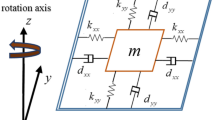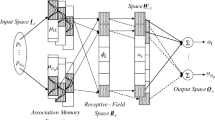Abstract
In this study, a model-free self-tuning output recurrent cerebellar model articulation controller (SORCMAC) is investigated to control a wheeled inverted pendulum (WIP). Since the proposed SORCMAC captures the system dynamics, it has superior capability compared to the conventional cerebellar model articulation controller in terms of an efficient learning mechanism and dynamic response. The dynamic gradient descent method is also adopted to adjust the SORCMAC parameters online. Moreover, an analytical method based on a Lyapunov function is proposed to determine the learning rates of the SORCMAC so that the convergence of the system can be guaranteed. Finally, the effectiveness of the proposed control system is verified by simulations of the WIP control. Simulation results show that the WIP can move forward and backward stably with uncertainty disturbance by using the proposed SORCMAC.







Similar content being viewed by others
Explore related subjects
Discover the latest articles, news and stories from top researchers in related subjects.References
Ren TJ, Chen TC, Chen CJ (2008) Motion control for a two-wheeled vehicle using a self-tuning PID controller. Control Eng Pract 16(3):365–375
Jung S, Kim SS (2008) Control experiment of a wheel-driven mobile inverted pendulum using neural network. IEEE Control Syst Technol 16(2):297–303
Grasser F, D’Arrigo A, Colombi S, Rufer AC (2002) JOE: a mobile, inverted pendulum. IEEE Trans Ind Electron 39(1):107–114
Pathak K, Franch J, Agrawal SK (2005) Velocity and position control of a wheeled inverted pendulum by partial feedback linearization. IEEE Trans Robot 21(3):505–513
Sashida T, Kenjo T (1993) An introduction to ultrasonic motors. Clarendon, Oxford
He S, Chen W, Tao X, Chen Z (1998) Standing wave bi-directional linearly moving ultrasonic motor. IEEE Trans Ultrason Ferroelectr Freq Control 45(5):1133–1139
Er MJ, Kee BH, Tan CC (2002) Design and development of an intelligent control for a pole-balancing robot. Microprocess Microsyst 26:433–448
Agarwal A (1997) A systematic classification of neural-network-based control. IEEE Control Syst Mag 17:75–93
Kuschewski JG, Hui S, Zak SH (1993) Application of feed-forward neural networks to dynamical system identification and control. IEEE Trans Control Syst Technol 1(1):37–49
Lin CM, Hsu CF (2002) Neural-network-based adaptive control for induction servomotor drive system. IEEE Trans Ind Electron 49(1):115–123
Chow TWS, Fang Y (1998) A recurrent neural-network-based real-time learning control strategy applying to nonlinear systems with unknown dynamics. IEEE Trans Ind Electron 45(1):151–161
Lin CM, Hsu CF (2002) Recurrent neural network adaptive control of wing-rock motion. J Guid Control Dyn 25(6):1163–1165
Hwang CL, Jan C, Chen YH (2001) Piezomechanics using intelligent variable-structure control. IEEE Trans Ind Electron 48(1):47–59
Hsu CF (2009) Design of intelligent power controller for DC-DC converter using CMAC neural network. Neural Comput Appl 18(1):93–103
Hwang KS, Lin CS (1998) Smooth trajectory tracking of three-link robot: a self-organizing CMAC approach. IEEE Trans Syst Man Cybern B 28(5):680–692
Gonzalez-Serrano FJ, Figueiras-Vidal AR, Artes-Rodriguez A (1998) Generalizing CMAC architecture and training. IEEE Trans Neural Netw 9(6):1509–1514
Jan JC, Hung SL (2001) High-order MS_CMAC neural network. IEEE Trans Neural Netw 12(3):598–603
Chen JY, Tsai PS, Wong CC (2005) Adaptive design of a fuzzy cerebellar model arithmetic controller neural network. IEEE Proc Control Theory Appl 152(2):133–137
Chiang CT, Lin CS (1996) CMAC with general basis functions. Neural Netw 9(7):1199–1211
Kim YH, Lewis FL (2000) Optimal design of CMAC neural-network controller for robot manipulators. IEEE Trans Syst Man Cybern C 30(1):22–31
Lee CH, Teng CC (2000) Identification and control of dynamic systems using recurrent fuzzy neural networks. IEEE Trans Fuzzy Syst 8(4):349–366
Lin FJ, Shyu KK, Wai RJ (2001) Recurrent-fuzzy-neural-network sliding-mode controlled motor-toggle servomechanism. IEEE/ASME Trans Mechatron 6(4):453–466
Chow TWS, Fang Y (1998) A recurrent neural-network-based real-time learning control strategy applying to nonlinear systems with unknown dynamics. IEEE Trans Ind Electron 45(1):151–161
Jagannathan S (1999) Discrete-time CMAC NN control of feedback linearizable nonlinear systems under a persistence of excitation. IEEE Trans Neural Netw 10(1):128–137
Lin FJ, Lin CM, Hong CM (2000) Robust control of linear synchronous motor servodrive using disturbance observer and recurrent neural network compensator. IEEE Proc Electr Power Appl 147(4):263–272
Peng YF, Wai RJ, Lin CM (2004) Implementation of LLCC-resonant driving circuit and adaptive CMAC neural network control for linear piezoelectric ceramic motor. IEEE Trans Ind Electron 51(1):35–48
Acknowledgments
This work was supported by the National Science Council of Taiwan, ROC under the Grant NSC96-2221-E-155-072.
Author information
Authors and Affiliations
Corresponding author
Appendix
Appendix
1.1 Proof of Theorem 1
Since
it follows that
where \( {\frac{\partial u}{{\partial w_{k} }}} = b_{k} \), \( {\frac{\partial u}{{\partial m_{ik} }}} = w_{k} b_{k} {\frac{{2(x_{ri} - m_{ik} )}}{{v_{ik}^{2} }}} \), \( {\frac{\partial u}{{\partial v_{ik} }}} = w_{k} b_{k} {\frac{{2(x_{ri} - m_{ik} )^{2} }}{{v_{ik}^{3} }}} \) and \( {\frac{\partial u}{{\partial r_{i} }}} = {\frac{1}{{r_{i} }}}y(N - 1). \) Define a Lyapunov function as
Then, the change of the Lyapunov function is obtained as
where \( e_{m} (N + 1) \) is represented by
Using (17), it is clear that
Thus,
From (A6) and (A9), \( \Updelta V(N) \) can be represented as
If β s is chosen as \( 0 < \beta_{s} < {\frac{2}{{||{\mathbf{P}}_{s} (N)||^{2} \left[ {{{\rho_{p} } \mathord{\left/ {\vphantom {{\rho_{p} } {e_{m} (N)}}} \right. \kern-\nulldelimiterspace} {e_{m} (N)}}} \right]^{2} }}} \), \( \Updelta V(N) \) in (A10) is less than 0. Therefore, the Lyapunov stability of \( V > 0 \) and \( \Updelta V < 0 \) is guaranteed. Moreover, the optimal learning rates are chosen as \( \beta_{s}^{*} = {\frac{1}{{||{\mathbf{P}}_{s} (N)||^{2} \left[ {{{\rho_{p} } \mathord{\left/ {\vphantom {{\rho_{p} } {e_{m} (N)}}} \right. \kern-\nulldelimiterspace} {e_{m} (N)}}} \right]^{2} }}} \). This shows an interesting result of the variable optimal learning rates which can be adjusted online at each instant.
Rights and permissions
About this article
Cite this article
Chiu, CH. Self-tuning output recurrent cerebellar model articulation controller for a wheeled inverted pendulum control. Neural Comput & Applic 19, 1153–1164 (2010). https://doi.org/10.1007/s00521-009-0335-2
Received:
Accepted:
Published:
Issue Date:
DOI: https://doi.org/10.1007/s00521-009-0335-2




